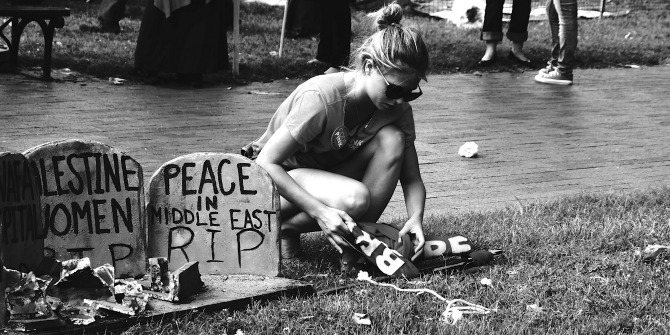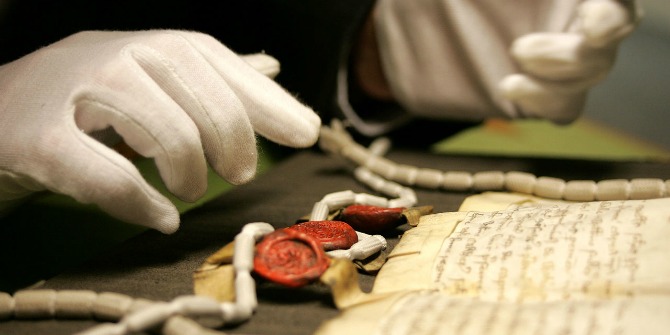 Kevin Guyan provides background on the Student Engager project, a UCL programme for PhD students to engage with the public over museum collections and ongoing research. Projects like this could play a vital role in training the next generation of academics in a way that highlights the benefits of sharing research with non-university audiences.
Kevin Guyan provides background on the Student Engager project, a UCL programme for PhD students to engage with the public over museum collections and ongoing research. Projects like this could play a vital role in training the next generation of academics in a way that highlights the benefits of sharing research with non-university audiences.
If you visit one of UCL’s campus museums this week you are likely to encounter a PhD researcher working in the space. But instead of using the space to conduct research, the PhD student’s presence in the museum is to strike-up conversations with visitors, exchange their thoughts on the objects on display and share insights into the latest developments in their research field.
The placement of PhD researchers in university museums is a key component of the Student Engager project, an initiative started by UCL’s Public and Cultural Engagement Department in 2012. The project currently employs 17 PhD students from diverse disciplines that include Molecular Cell Biology, Archaeology and Security and Crime Science. Engagers work three-hour shifts every one to two weeks within the Grant Museum of Zoology, the Petrie Museum of Egyptian Archaeology and the UCL Art Museum. While working in the museum, engagers initiate conversations with visitors and draw (often unexpected) connections between the museum collections and their research subjects. The experience pushes engagers outside of their comfort zones, forces them to think about the interdisciplinary potential of their work and find ways to communicate complex knowledge with non-specialist audiences.
 Image credit: Petrie Museum of Egyptian Archaeology by – CC BY-SA 4.0 via Wikimedia
Image credit: Petrie Museum of Egyptian Archaeology by – CC BY-SA 4.0 via Wikimedia
PhD students receive payment for time spent working on the project and are encouraged to seize public engagement opportunities that emerge through their work, both inside and outside the university setting. The Student Engager project also gives PhD students the opportunity to organise public events and work with other university curators, conservators and exhibitions staff, with past examples including LandSCAPE (2013), Movement (2014) and the exhibition Stress: Approaches to the First World War (2015).
While studying for my PhD in History at UCL, I worked as a student engager in the campus museums and found that, even in the first year of my research, there was potential for my own work to have impact. I used museum engagement sessions to share images from my research into men’s domestic experiences as fathers and husbands in Britain between 1941 and 1961. Conversations with visitors would quickly move beyond the narrow parameters of my own study as people felt encouraged to recall where their father sat in the living room, memories of when dad returned from war or how family life changed when they moved to a new estate. My engagements provided visitors with opportunities to think about their own domestic experiences as something that transcends the specifics of their individual lives, as well as informing the direction of my doctoral project.
Alongside my work as coordinator of the Student Engager project, I have also worked as a Research Assistant and helped draft impact case studies ahead of REF 2014. Working across the fields of public engagement and research assessment, it became clear to me that initiatives like the Student Engager project could play a vital role in training the next generation of academics in a way that highlights the benefits of sharing research with non-university audiences. Although, there remain a few challenges to getter wider institutional recognition for these benefits.
The exchange of information between researchers and museum visitors presents a good example of public engagement but, as it is difficult to capture the effects the research has on the museum visitor, it fails to qualify as impact in terms of the REF. Furthermore, postgraduate students typically fall outside the criteria for inclusion in formal research assessment exercises like the REF.
The project’s value instead comes from its potential for long-term impacts. Among the project’s alumnus, some have continued in academia as early career researchers and found ways to build-upon the public engagement skills honed while sharing their research in university museums. I feel that the project has given me a wider knowledge of impact facilitating units that exist at UCL, such as the public engagement and communications team, and should I return to UCL in the future as academic staff, I would know who to contact in order to maximise the impact potential of my work. Most importantly, initiatives like the Student Engager project help alter the university landscape so that engagement with non-academic audiences becomes an everyday expectation of academic research.
University museums and collections hold a fantastic assortment of items. The Student Engager project presents a working example of how universities can find creative ways to share their material with public audiences and provide platforms for PhD students to develop skills as well-rounded researchers. When executed in a supportive way (with PhD students paid for their time), projects can also help recast universities as locations where the public can encounter ‘live research’, challenge the stereotype of PhD students among non-university audiences and help maximise the impact potential of research among those starting their academic careers.
Note: This article gives the views of the author, and not the position of the LSE Impact blog, nor of the London School of Economics. Please review our Comments Policy if you have any concerns on posting a comment below.
Kevin Guyan submitted his PhD in History at University College London in June 2016. He works as UCL’s Student Engagement Coordinator and assisted with the preparation of the university’s impact case studies ahead of REF 2014. Follow him on Twitter @kevin_guyan








1 Comments